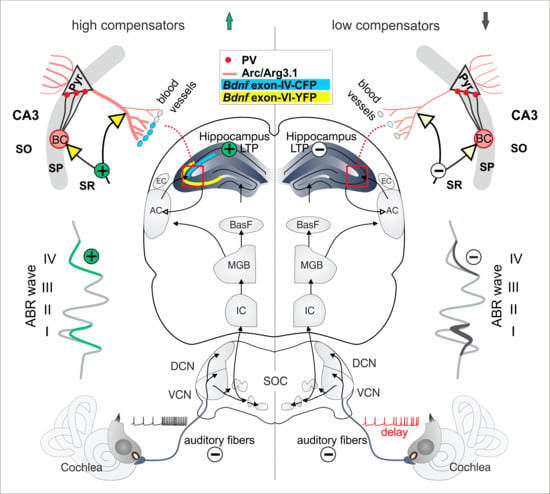Age-Dependent Auditory Processing Deficits after Cochlear Synaptopathy Depend on Auditory Nerve Latency and the Ability of the Brain to Recruit LTP/BDNF
Abstract
:1. Introduction
2. Materials and Methods
2.1. Animals
2.2. Hearing Measurements
2.3. Field Excitatory Postsynaptic Potential (fEPSP) Recordings in Hippocampal Slices
2.4. Tissue Preparation
2.5. Immunohistochemistry
2.6. Data Analyses
2.6.1. Statistics and Numbers
2.6.2. ABR Analysis
2.6.3. fEPSP Recordings in Hippocampal Slices
2.6.4. Fluorescence Analysis of Immunohistochemistry
2.6.5. Data Availability
3. Results
3.1. Auditory Brainstem Response-Evoked Thresholds Are Elevated in Old but Not Middle-Aged Animals
3.2. Late Supra-Threshold ABR Wave Varies in Middle-Aged and Old Animals
3.3. Central Compensation and Auditory Processing Following Age-Related Reduced Auditory Nerve Activity Differs Depending on Prevailed Latency of Auditory Nerve Response
3.4. Delayed Auditory Nerve Response and Attenuated Central Auditory Processing Due to Age-Dependent Reduced Auditory Nerve Activity Is Linked with Lower Hippocampal Long-Term Potentiation
3.5. Delayed Auditory Nerve Response and Attenuated Central Auditory Processing Due to Age-Dependent Reduced Auditory Nerve Activity Is Linked to Lower Levels of Hippocampal BDNF
4. Discussion
4.1. Auditory (Temporal) Processing Deficits Due to Age-Dependent Cochlear Synaptopathy Differ Depending on Prevailed Latency of Auditory Nerve Response
4.2. Auditory (Temporal) Processing Deficits Due to Age-Dependent Cochlear Synaptopathy Differ Depending on Hippocampal LTP and Bdnf Transcript Recruitment
Supplementary Materials
Author Contributions
Funding
Acknowledgments
Conflicts of Interest
Abbreviations
References
- Fullgrabe, C.; Moore, B.C. Effects of age and hearing loss on stream segregation based on interaural time differences. J. Acoust. Soc. Am. 2014, 136, EL185–EL191. [Google Scholar] [CrossRef]
- Bharadwaj, H.M.; Verhulst, S.; Shaheen, L.; Liberman, M.C.; Shinn-Cunningham, B.G. Cochlear neuropathy and the coding of supra-threshold sound. Front. Syst. Neurosci. 2014, 8, 26. [Google Scholar] [CrossRef] [Green Version]
- Bramhall, N.; Ong, B.; Ko, J.; Parker, M. Speech perception ability in noise is correlated with auditory brainstem response wave I amplitude. J. Am. Acad. Audiol. 2015, 26, 509–517. [Google Scholar] [CrossRef]
- Kujawa, S.G.; Liberman, M.C. Adding insult to injury: Cochlear nerve degeneration after “temporary” noise-induced hearing loss. J. Neurosci. 2009, 29, 14077–14085. [Google Scholar] [CrossRef] [Green Version]
- Sergeyenko, Y.; Lall, K.; Liberman, M.C.; Kujawa, S.G. Age-related cochlear synaptopathy: An early-onset contributor to auditory functional decline. J. Neurosci. 2013, 33, 13686–13694. [Google Scholar] [CrossRef]
- Möhrle, D.; Ni, K.; Varakina, K.; Bing, D.; Lee, S.C.; Zimmermann, U.; Knipper, M.; Rüttiger, L. Loss of auditory sensitivity from inner hair cell synaptopathy can be centrally compensated in the young but not old brain. Neurobiol. Aging 2016, 44, 173–184. [Google Scholar] [CrossRef] [Green Version]
- Viana, L.M.; O’Malley, J.T.; Burgess, B.J.; Jones, D.D.; Oliveira, C.A.; Santos, F.; Merchant, S.N.; Liberman, L.D.; Liberman, M.C. Cochlear neuropathy in human presbycusis: Confocal analysis of hidden hearing loss in post-mortem tissue. Hear. Res. 2015, 327, 78–88. [Google Scholar] [CrossRef] [PubMed] [Green Version]
- Liberman, M.C.; Kujawa, S.G. Cochlear synaptopathy in acquired sensorineural hearing loss: Manifestations and mechanisms. Hear. Res. 2017, 349, 138–147. [Google Scholar] [CrossRef]
- Kobel, M.; Le Prell, C.G.; Liu, J.; Hawks, J.W.; Bao, J. Noise-induced cochlear synaptopathy: Past findings and future studies. Hear. Res. 2017, 349, 148–154. [Google Scholar] [CrossRef]
- Furman, A.C.; Kujawa, S.G.; Liberman, M.C. Noise-induced cochlear neuropathy is selective for fibers with low spontaneous rates. J. Neurophysiol. 2013, 110, 577–586. [Google Scholar] [CrossRef]
- Schmiedt, R.A.; Mills, J.H.; Boettcher, F.A. Age-related loss of activity of auditory-nerve fibers. J. Neurophysiol. 1996, 76, 2799–2803. [Google Scholar] [PubMed]
- Parthasarathy, A.; Kujawa, S.G. Synaptopathy in the aging cochlea: Characterizing early-neural deficits in auditory temporal envelope processing. J. Neurosci. 2018, 38, 7108–7119. [Google Scholar] [CrossRef] [Green Version]
- Ridley, C.L.; Kopun, J.G.; Neely, S.T.; Gorga, M.P.; Rasetshwane, D.M. Using thresholds in noise to identify hidden hearing loss in humans. Ear Hear. 2018, 39, 829–844. [Google Scholar] [CrossRef]
- Heinz, M.G.; Young, E.D. Response growth with sound level in auditory-nerve fibers after noise-induced hearing loss. J. Neurophysiol. 2004, 91, 784–795. [Google Scholar]
- Heinz, M.G.; Issa, J.B.; Young, E.D. Auditory-nerve rate responses are inconsistent with common hypotheses for the neural correlates of loudness recruitment. J. Assoc. Res. Otolaryngol. 2005, 6, 91–105. [Google Scholar] [CrossRef]
- Ruel, J.; Chabbert, C.; Nouvian, R.; Bendris, R.; Eybalin, M.; Leger, C.L.; Bourien, J.; Mersel, M.; Puel, J.L. Salicylate enables cochlear arachidonic-acid-sensitive NMDA receptor responses. J. Neurosci. 2008, 28, 7313–7323. [Google Scholar] [CrossRef]
- King, K.; Stephens, D. Auditory and psychological factors in ‘auditory disability with normal hearing’. Scand. Audiol. 1992, 21, 109–114. [Google Scholar] [CrossRef]
- Saunders, G.H.; Field, D.L.; Haggard, M.P. A clinical test battery for obscure auditory dysfunction (OAD): Development, selection and use of tests. Br. J. Audiol. 1992, 26, 33–42. [Google Scholar] [CrossRef]
- Stephens, D.; Zhao, F. The role of a family history in king kopetzky syndrome (obscure auditory dysfunction). Acta Otolaryngol. 2000, 120, 197–200. [Google Scholar] [CrossRef]
- Kuwada, S.; Anderson, J.S.; Batra, R.; Fitzpatrick, D.C.; Teissier, N.; D’Angelo, W.R. Sources of the scalp-recorded amplitude-modulation following response. J. Am. Acad. Audiol. 2002, 13, 188–204. [Google Scholar] [CrossRef] [PubMed]
- Bidet-Caulet, A.; Fischer, C.; Besle, J.; Aguera, P.E.; Giard, M.H.; Bertrand, O. Effects of selective attention on the electrophysiological representation of concurrent sounds in the human auditory cortex. J. Neurosci. 2007, 27, 9252–9261. [Google Scholar] [CrossRef]
- Brugge, J.F.; Nourski, K.V.; Oya, H.; Reale, R.A.; Kawasaki, H.; Steinschneider, M.; Howard, M.A., 3rd. Coding of repetitive transients by auditory cortex on Heschl’s gyrus. J. Neurophysiol. 2009, 102, 2358–2374. [Google Scholar] [CrossRef] [Green Version]
- Grose, J.H.; Buss, E.; Elmore, H. Age-related changes in the auditory brainstem response and suprathreshold processing of temporal and spectral modulation. Trends Hear. 2019, 23. [Google Scholar] [CrossRef] [Green Version]
- Matt, L.; Eckert, P.; Panford-Walsh, R.; Geisler, H.S.; Bausch, A.E.; Manthey, M.; Muller, N.I.C.; Harasztosi, C.; Rohbock, K.; Ruth, P.; et al. Visualizing BDNF transcript usage during sound-induced memory linked plasticity. Front. Mol. Neurosci. 2018, 11, 260. [Google Scholar] [CrossRef] [Green Version]
- Kamerer, A.M.; AuBuchon, A.; Fultz, S.E.; Kopun, J.G.; Neely, S.T.; Rasetshwane, D.M. The role of cognition in common measures of peripheral synaptopathy and hidden hearing loss. Am. J. Audiol. 2019, 28, 843–856. [Google Scholar] [CrossRef]
- Singer, W.; Manthey, M.; Panford-Walsh, R.; Matt, L.; Geisler, H.S.; Passeri, E.; Baj, G.; Tongiorgi, E.; Leal, G.; Duarte, C.B.; et al. BDNF-live-exon-visualization (BLEV) allows differential detection of BDNF transcripts in vitro and in vivo. Front. Mol. Neurosci. 2018, 11, 325. [Google Scholar] [CrossRef] [PubMed]
- Melcher, J.R.; Kiang, N.Y. Generators of the brainstem auditory evoked potential in cat. III: Identified cell populations. Hear. Res. 1996, 93, 52–71. [Google Scholar]
- Engel, J.; Braig, C.; Rüttiger, L.; Kuhn, S.; Zimmermann, U.; Blin, N.; Sausbier, M.; Kalbacher, H.; Münkner, S.; Rohbock, K.; et al. Two classes of outer hair cells along the tonotopic axis of the cochlea. Neuroscience 2006, 143, 837–849. [Google Scholar]
- Burkard, R.F.; Don, M. The auditory brainstem response. In Auditory Evoked Potentials: Basic Principles and Clinical Application; Burkard, R.F., Eggermont, J.J., Don, M., Eds.; Lippincott Williams and Wilkins: Philadelphia, PA, USA, 2007. [Google Scholar]
- Matt, L.; Michalakis, S.; Hofmann, F.; Hammelmann, V.; Ludwig, A.; Biel, M.; Kleppisch, T. HCN2 channels in local inhibitory interneurons constrain LTP in the hippocampal direct perforant path. Cell. Mol. Life Sci. 2011, 68, 125–137. [Google Scholar] [CrossRef]
- Chenaux, G.; Matt, L.; Hill, T.C.; Kaur, I.; Liu, X.-B.; Kirk, L.M.; Speca, D.J.; McMahon, S.A.; Zito, K.; Hell, J.W.; et al. Loss of SynDIG1 reduces excitatory synapse maturation but not formation in vivo. SynDIG1 regulates excitatory synapse maturation. ENeuro 2016, 3. [Google Scholar] [CrossRef] [Green Version]
- Singer, W.; Geisler, H.S.; Panford-Walsh, R.; Knipper, M. Detection of excitatory and inhibitory synapses in the auditory system using fluorescence immunohistochemistry and high-resolution fluorescence microscopy. Methods Mol. Biol. 2016, 1427, 263–276. [Google Scholar] [CrossRef]
- Zampini, V.; Johnson, S.L.; Franz, C.; Lawrence, N.D.; Munkner, S.; Engel, J.; Knipper, M.; Magistretti, J.; Masetto, S.; Marcotti, W. Elementary properties of CaV1.3 Ca(2+) channels expressed in mouse cochlear inner hair cells. J. Physiol. 2010, 588, 187–199. [Google Scholar] [CrossRef] [Green Version]
- Chumak, T.; Rüttiger, L.; Lee, S.C.; Campanelli, D.; Zuccotti, A.; Singer, W.; Popelar, J.; Gutsche, K.; Geisler, H.S.; Schraven, S.P.; et al. BDNF in lower brain parts modifies auditory fiber activity to gain fidelity but increases the risk for generation of central noise after injury. Mol. Neurobiol. 2016, 53, 5607–5627. [Google Scholar] [CrossRef] [Green Version]
- Marchetta, P.; Mohrle, D.; Eckert, P.; Reimann, K.; Wolter, S.; Tolone, A.; Lang, I.; Wolters, M.; Feil, R.; Engel, J.; et al. Guanylyl cyclase A/cGMP signaling slows hidden, age- and acoustic trauma-induced hearing loss. Front. Aging Neurosci. 2020, 12, 83. [Google Scholar] [CrossRef] [Green Version]
- Gleich, O.; Semmler, P.; Strutz, J. Behavioral auditory thresholds and loss of ribbon synapses at inner hair cells in aged gerbils. Exp. Gerontol. 2016, 84, 61–70. [Google Scholar] [CrossRef] [PubMed]
- Valero, M.D.; Burton, J.A.; Hauser, S.N.; Hackett, T.A.; Ramachandran, R.; Liberman, M.C. Noise-induced cochlear synaptopathy in rhesus monkeys (Macaca mulatta). Hear. Res. 2017, 353, 213–223. [Google Scholar] [CrossRef]
- Wu, P.Z.; Liberman, L.D.; Bennett, K.; de Gruttola, V.; O’Malley, J.T.; Liberman, M.C. Primary neural degeneration in the human cochlea: Evidence for hidden hearing loss in the aging ear. Neuroscience 2019, 407, 8–20. [Google Scholar] [CrossRef]
- Johnson, D.H.; Kiang, N.Y. Analysis of discharges recorded simultaneously from pairs of auditory nerve fibers. Biophys. J. 1976, 16, 719–734. [Google Scholar] [PubMed] [Green Version]
- Buran, B.N.; Strenzke, N.; Neef, A.; Gundelfinger, E.D.; Moser, T.; Liberman, M.C. Onset coding is degraded in auditory nerve fibers from mutant mice lacking synaptic ribbons. J. Neurosci. 2010, 30, 7587–7597. [Google Scholar] [CrossRef]
- Jaumann, M.; Dettling, J.; Gubelt, M.; Zimmermann, U.; Gerling, A.; Paquet-Durand, F.; Feil, S.; Wolpert, S.; Franz, C.; Varakina, K.; et al. cGMP-Prkg1 signaling and Pde5 inhibition shelter cochlear hair cells and hearing function. Nat. Med. 2012, 18, 252–259. [Google Scholar] [CrossRef] [PubMed]
- Rüttiger, L.; Zimmermann, U.; Knipper, M. Biomarkers for hearing dysfunction: facts and outlook. ORL 2017, 79, 93–111. [Google Scholar] [CrossRef]
- Khimich, D.; Nouvian, R.; Pujol, R.; Tom Dieck, S.; Egner, A.; Gundelfinger, E.D.; Moser, T. Hair cell synaptic ribbons are essential for synchronous auditory signalling. Nature 2005, 434, 889–894. [Google Scholar]
- Rhode, W.S.; Smith, P.H. Encoding timing and intensity in the ventral cochlear nucleus of the cat. J. Neurophysiol. 1986, 56, 261–286. [Google Scholar] [CrossRef] [PubMed]
- Rhode, W.S.; Smith, P.H. Physiological studies on neurons in the dorsal cochlear nucleus of cat. J. Neurophysiol. 1986, 56, 287–307. [Google Scholar] [CrossRef]
- Hu, H.; Gan, J.; Jonas, P. Interneurons. Fast-spiking, parvalbumin+ GABAergic interneurons: From cellular design to microcircuit function. Science 2014, 345, 1255263. [Google Scholar] [CrossRef] [PubMed]
- Ouda, L.; Profant, O.; Syka, J. Age-related changes in the central auditory system. Cell Tissue Res. 2015, 361, 337–358. [Google Scholar] [CrossRef]
- Williamson, T.T.; Zhu, X.; Walton, J.P.; Frisina, R.D. Auditory brainstem gap responses start to decline in mice in middle age: A novel physiological biomarker for age-related hearing loss. Cell Tissue Res. 2015, 361, 359–369. [Google Scholar] [CrossRef]
- Frisina, D.R.; Frisina, R.D. Speech recognition in noise and presbycusis: Relations to possible neural mechanisms. Hear. Res. 1997, 106, 95–104. [Google Scholar] [CrossRef] [PubMed]
- Kujawa, S.G.; Liberman, M.C. Synaptopathy in the noise-exposed and aging cochlea: Primary neural degeneration in acquired sensorineural hearing loss. Hear. Res. 2015, 330, 191–199. [Google Scholar] [CrossRef] [Green Version]
- Bourien, J.; Tang, Y.; Batrel, C.; Huet, A.; Lenoir, M.; Ladrech, S.; Desmadryl, G.; Nouvian, R.; Puel, J.L.; Wang, J. Contribution of auditory nerve fibers to compound action potential of the auditory nerve. J. Neurophysiol. 2014, 112, 1025–1039. [Google Scholar] [CrossRef] [Green Version]
- Frisina, R.D.; Karcich, K.J.; Tracy, T.C.; Sullivan, D.M.; Walton, J.P.; Colombo, J. Preservation of amplitude modulation coding in the presence of background noise by chinchilla auditory-nerve fibers. J. Acoust. Soc. Am. 1996, 99, 475–490. [Google Scholar] [CrossRef] [PubMed]
- Grose, J.H.; Buss, E.; Hall, J.W., 3rd. Loud music exposure and cochlear synaptopathy in young adults: Isolated auditory brainstem response effects but no perceptual consequences. Trends Hear. 2017, 21, 2331216517737417. [Google Scholar] [CrossRef]
- Prendergast, G.; Guest, H.; Munro, K.J.; Kluk, K.; Leger, A.; Hall, D.A.; Heinz, M.G.; Plack, C.J. Effects of noise exposure on young adults with normal audiograms I: Electrophysiology. Hear. Res. 2017, 344, 68–81. [Google Scholar] [CrossRef] [PubMed]
- Yeend, I.; Beach, E.F.; Sharma, M.; Dillon, H. The effects of noise exposure and musical training on suprathreshold auditory processing and speech perception in noise. Hear. Res. 2017, 353, 224–236. [Google Scholar] [CrossRef] [PubMed] [Green Version]
- Yates, G.K. Auditory-nerve spontaneous rates vary predictably with threshold. Hear. Res. 1991, 57, 57–62. [Google Scholar] [PubMed]
- Knipper, M.; van Dijk, P.; Schulze, H.; Mazurek, B.; Krauss, P.; Scheper, V.; Warnecke, A.; Schlee, W.; Schwabe, k.; Singer, W.; et al. The neural bases of tinnitus: Lessons from deafness and cochlear implants. J. Neurosci. 2020, 40, 7190–7202. [Google Scholar]
- Schaette, R.; Kempter, R. Predicting tinnitus pitch from patients’ audiograms with a computational model for the development of neuronal hyperactivity. J. Neurophysiol. 2009, 101, 3042–3052. [Google Scholar] [CrossRef] [PubMed] [Green Version]
- Schaette, R.; Kempter, R. Computational models of neurophysiological correlates of tinnitus. Front. Syst. Neurosci. 2012, 6, 34. [Google Scholar] [CrossRef] [Green Version]
- Caspary, D.M.; Milbrandt, J.C.; Helfert, R.H. Central auditory aging: GABA changes in the inferior colliculus. Exp. Gerontol. 1995, 30, 349–360. [Google Scholar] [CrossRef] [PubMed]
- Levakova, M.; Tamborrino, M.; Ditlevsen, S.; Lansky, P. A review of the methods for neuronal response latency estimation. Biosystems 2015, 136, 23–34. [Google Scholar] [CrossRef]
- Heeringa, A.N.; van Dijk, P. The dissimilar time course of temporary threshold shifts and reduction of inhibition in the inferior colliculus following intense sound exposure. Hear. Res. 2014, 312, 38–47. [Google Scholar] [CrossRef] [Green Version]
- Cai, S.; Ma, W.L.; Young, E.D. Encoding intensity in ventral cochlear nucleus following acoustic trauma: Implications for loudness recruitment. J. Assoc. Res. Otolaryngol. 2009, 10, 5–22. [Google Scholar] [CrossRef] [PubMed] [Green Version]
- Irvine, D.R.F. Plasticity in the auditory system. Hear. Res. 2018, 362, 61–73. [Google Scholar] [CrossRef]
- Kraus, N.; White-Schwoch, T. Unraveling the biology of auditory learning: A cognitive-sensorimotor-reward framework. Trends Cogn. Sci. 2015, 19, 642–654. [Google Scholar] [CrossRef] [Green Version]
- Kilgard, M.P.; Pandya, P.K.; Engineer, N.D.; Moucha, R. Cortical network reorganization guided by sensory input features. Biol. Cybern. 2002, 87, 333–343. [Google Scholar] [CrossRef] [PubMed]
- Schonwiesner, M.; Novitski, N.; Pakarinen, S.; Carlson, S.; Tervaniemi, M.; Naatanen, R. Heschl’s gyrus, posterior superior temporal gyrus, and mid-ventrolateral prefrontal cortex have different roles in the detection of acoustic changes. J. Neurophysiol. 2007, 97, 2075–2082. [Google Scholar] [CrossRef] [Green Version]
- Malmierca, M.S.; Sanchez-Vives, M.V.; Escera, C.; Bendixen, A. Neuronal adaptation, novelty detection and regularity encoding in audition. Front. Syst. Neurosci. 2014, 8, 111. [Google Scholar] [CrossRef]
- Weinberger, N.M. New perspectives on the auditory cortex: Learning and memory. Handb. Clin. Neurol. 2015, 129, 117–147. [Google Scholar] [CrossRef]
- de Kloet, E.R. From receptor balance to rational glucocorticoid therapy. Endocrinology 2014, 155, 2754–2769. [Google Scholar] [CrossRef]
- Irvine, D.R.F. Auditory perceptual learning and changes in the conceptualization of auditory cortex. Hear. Res. 2018, 366, 3–16. [Google Scholar] [CrossRef]
- Viho, E.M.G.; Buurstede, J.C.; Mahfouz, A.; Koorneef, L.L.; van Weert, L.; Houtman, R.; Hunt, H.J.; Kroon, J.; Meijer, O.C. Corticosteroid action in the brain: The potential of selective receptor modulation. Neuroendocrinology 2019, 109, 266–276. [Google Scholar] [CrossRef]
- Kaltenbach, J.A.; Zhang, J. Intense sound-induced plasticity in the dorsal cochlear nucleus of rats: Evidence for cholinergic receptor upregulation. Hear. Res. 2007, 226, 232–243. [Google Scholar] [PubMed]
- Salvi, R.J.; Wang, J.; Ding, D. Auditory plasticity and hyperactivity following cochlear damage. Hear. Res. 2000, 147, 261–274. [Google Scholar]
- Wang, H.; Brozoski, T.J.; Turner, J.G.; Ling, L.; Parrish, J.L.; Hughes, L.F.; Caspary, D.M. Plasticity at glycinergic synapses in dorsal cochlear nucleus of rats with behavioral evidence of tinnitus. Neuroscience 2009, 164, 747–759. [Google Scholar]
- Dehmel, S.; Pradhan, S.; Koehler, S.; Bledsoe, S.; Shore, S. Noise overexposure alters long-term somatosensory-auditory processing in the dorsal cochlear nucleus—Possible basis for tinnitus-related hyperactivity? J. Neurosci. 2012, 32, 1660–1671. [Google Scholar] [CrossRef]
- Groschel, M.; Ryll, J.; Gotze, R.; Ernst, A.; Basta, D. Acute and long-term effects of noise exposure on the neuronal spontaneous activity in cochlear nucleus and inferior colliculus brain slices. Biomed. Res. Int. 2014, 2014, 909260. [Google Scholar] [CrossRef]
- Vogler, D.P.; Robertson, D.; Mulders, W.H. Hyperactivity in the ventral cochlear nucleus after cochlear trauma. J. Neurosci. 2011, 31, 6639–6645. [Google Scholar] [CrossRef]
- Sowell, E.R.; Delis, D.; Stiles, J.; Jernigan, T.L. Improved memory functioning and frontal lobe maturation between childhood and adolescence: A structural MRI study. J. Int. Neuropsychol. Soc. 2001, 7, 312–322. [Google Scholar]
- Nunez, A.; Malmierca, E. Corticofugal modulation of sensory information. Adv. Anat. Embryol. Cell Biol. 2007, 187, 1–74. [Google Scholar] [PubMed]
- Wittekindt, A.; Kaiser, J.; Abel, C. Attentional modulation of the inner ear: A combined otoacoustic emission and EEG study. J. Neurosci. 2014, 34, 9995–10002. [Google Scholar] [CrossRef] [PubMed] [Green Version]
- Dragicevic, C.D.; Marcenaro, B.; Navarrete, M.; Robles, L.; Delano, P.H. Oscillatory infrasonic modulation of the cochlear amplifier by selective attention. PLoS ONE 2019, 14, e0208939. [Google Scholar] [CrossRef] [Green Version]
- Miller, E.K.; Buschman, T.J. Cortical circuits for the control of attention. Curr. Opin. Neurobiol. 2013, 23, 216–222. [Google Scholar] [CrossRef]
- Singer, W.; Gröschel, M.; Zuccotti, A.; Mueller, S.; Ernst, A.; Basta, D.; Knipper, M.; Rüttiger, L. The aftermath of tinnitus-inducing inner ear damage for auditory brainstem responses and MEMR imaging of central brain activity in the rat. Hear. Balance Commun. Artic. 2020, 1–9. [Google Scholar] [CrossRef]
- Arango-Lievano, M.; Borie, A.M.; Dromard, Y.; Murat, M.; Desarmenien, M.G.; Garabedian, M.J.; Jeanneteau, F. Persistence of learning-induced synapses depends on neurotrophic priming of glucocorticoid receptors. Proc. Natl. Acad. Sci. USA 2019, 116, 13097–13106. [Google Scholar] [CrossRef] [PubMed] [Green Version]
- Dieni, S.; Matsumoto, T.; Dekkers, M.; Rauskolb, S.; Ionescu, M.S.; Deogracias, R.; Gundelfinger, E.D.; Kojima, M.; Nestel, S.; Frotscher, M.; et al. BDNF and its pro-peptide are stored in presynaptic dense core vesicles in brain neurons. J. Cell Biol. 2012, 196, 775–788. [Google Scholar] [CrossRef] [Green Version]
- Chacon-Fernandez, P.; Sauberli, K.; Colzani, M.; Moreau, T.; Ghevaert, C.; Barde, Y.A. Brain-derived neurotrophic factor in megakaryocytes. J. Biol. Chem. 2016, 291, 9872–9881. [Google Scholar] [CrossRef] [Green Version]
- Hillman, E.M. Coupling mechanism and significance of the BOLD signal: A status report. Annu. Rev. Neurosci. 2014, 37, 161–181. [Google Scholar] [CrossRef] [Green Version]
- Broadway, J.M.; Engle, R.W. Lapsed attention to elapsed time? Individual differences in working memory capacity and temporal reproduction. Acta Psychol. 2011, 137, 115–126. [Google Scholar] [CrossRef]
- Fullgrabe, C.; Moore, B.C.; Stone, M.A. Age-group differences in speech identification despite matched audiometrically normal hearing: Contributions from auditory temporal processing and cognition. Front. Aging Neurosci. 2014, 6, 347. [Google Scholar] [CrossRef]
- Tucsek, Z.; Valcarcel-Ares, M.N.; Tarantini, S.; Yabluchanskiy, A.; Fulop, G.; Gautam, T.; Orock, A.; Csiszar, A.; Deak, F.; Ungvari, Z. Hypertension-induced synapse loss and impairment in synaptic plasticity in the mouse hippocampus mimics the aging phenotype: Implications for the pathogenesis of vascular cognitive impairment. Geroscience 2017, 39, 385–406. [Google Scholar] [CrossRef]
- Shi, Y.; Thrippleton, M.J.; Makin, S.D.; Marshall, I.; Geerlings, M.I.; de Craen, A.J.M.; van Buchem, M.A.; Wardlaw, J.M. Cerebral blood flow in small vessel disease: A systematic review and meta-analysis. J. Cereb. Blood Flow Metab. 2016, 36, 1653–1667. [Google Scholar] [CrossRef] [Green Version]
- Lin, V.Y.; Chung, J.; Callahan, B.L.; Smith, L.; Gritters, N.; Chen, J.M.; Black, S.E.; Masellis, M. Development of cognitive screening test for the severely hearing impaired: Hearing-impaired MoCA. Laryngoscope 2017, 127 (Suppl. 1), S4–S11. [Google Scholar] [CrossRef]
- Livingston, G.; Frankish, H. A global perspective on dementia care: A lancet commission. Lancet 2015, 386, 933–934. [Google Scholar] [CrossRef]
- Montero-Odasso, M.; Ismail, Z.; Livingston, G. One third of dementia cases can be prevented within the next 25 years by tackling risk factors. The case “for” and “against”. Alzheimer’s Res. Ther. 2020, 12, 81. [Google Scholar] [CrossRef]
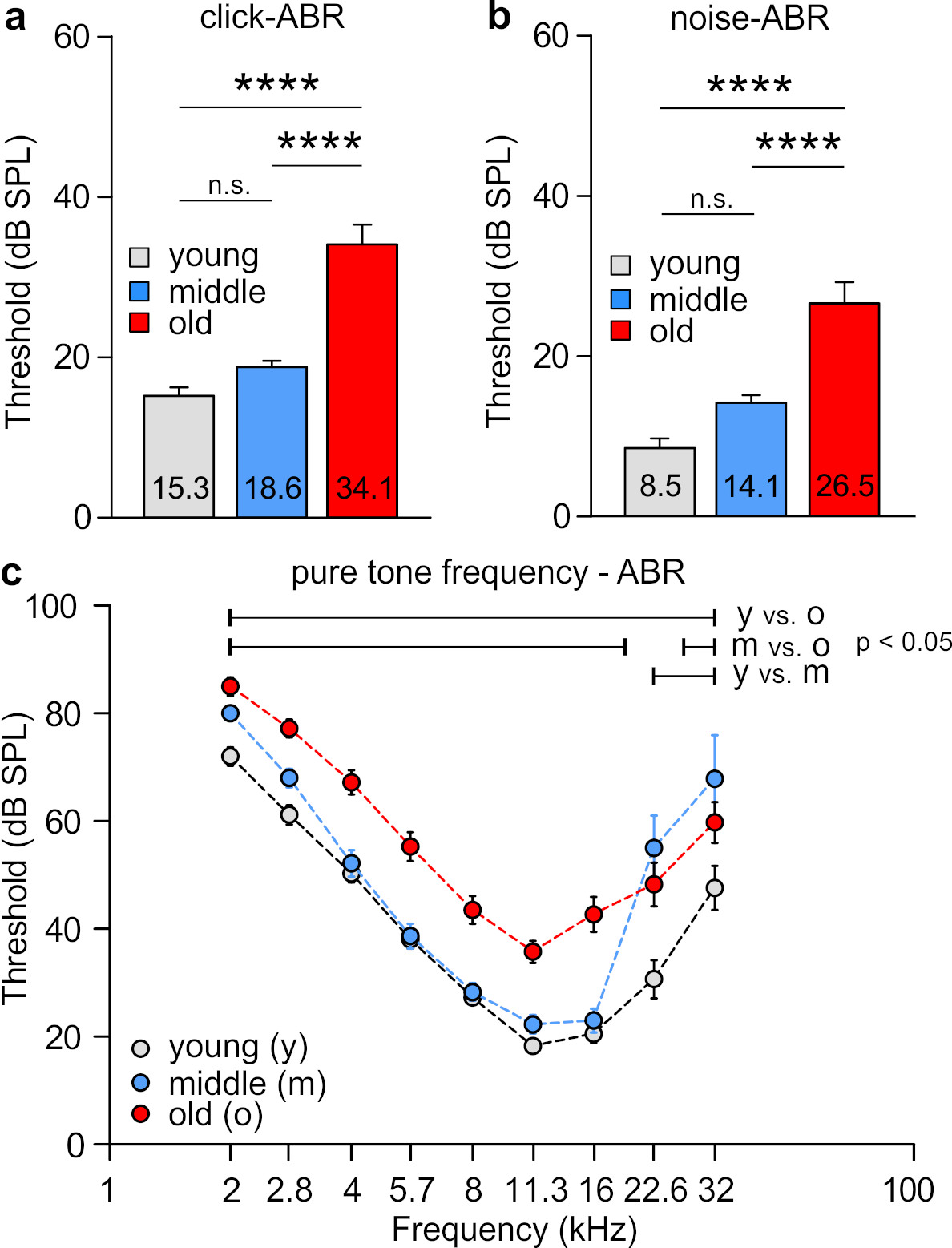
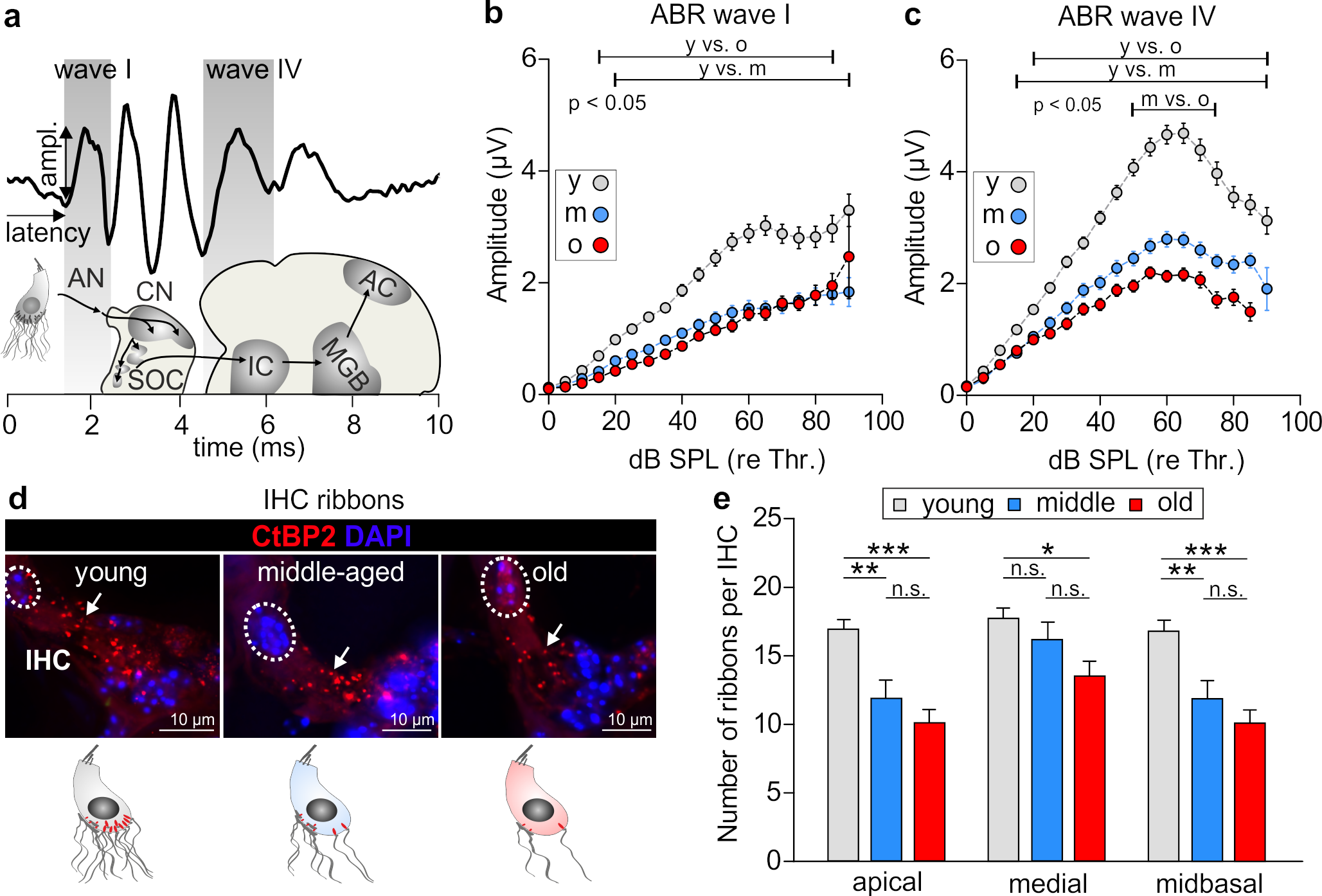
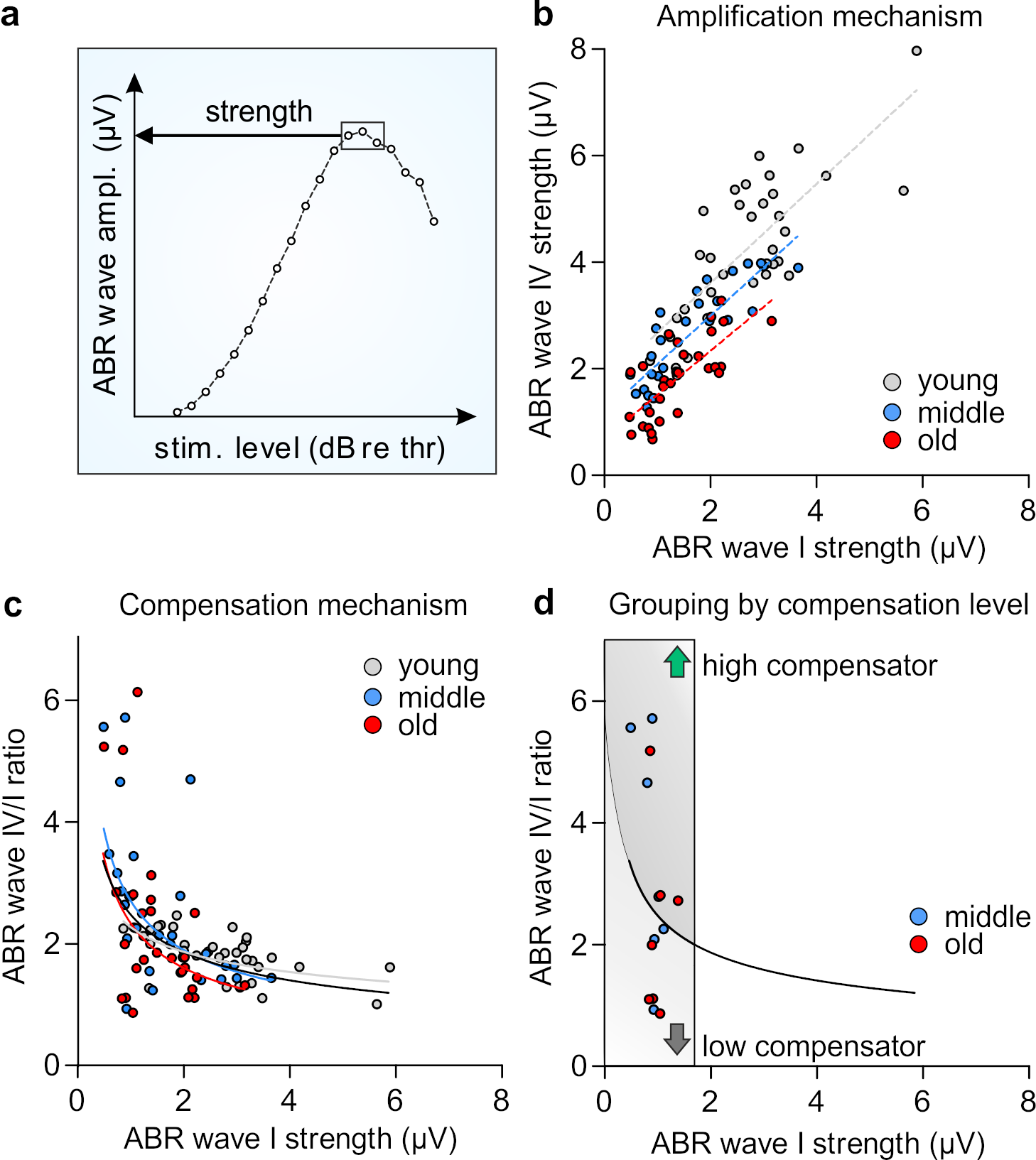
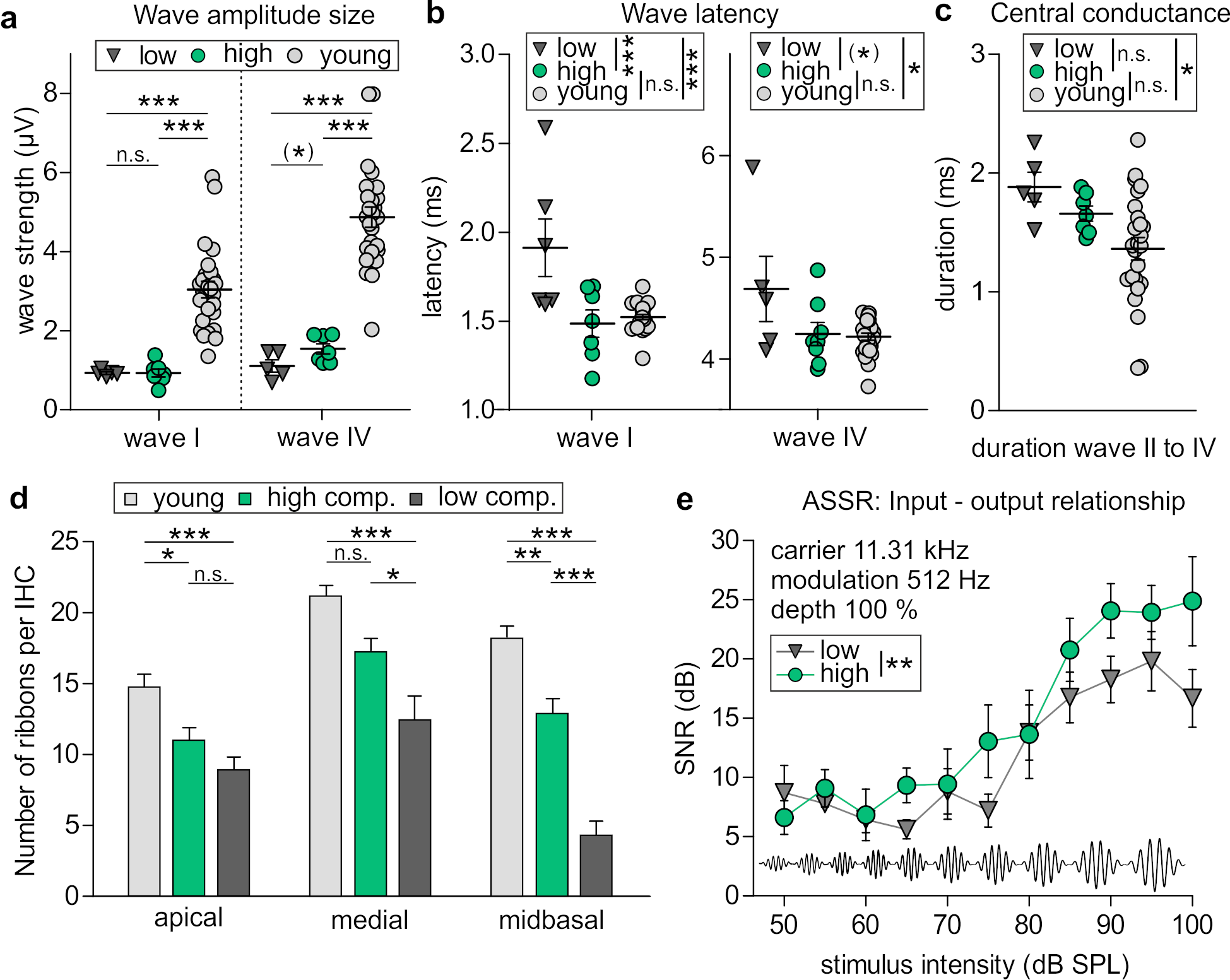


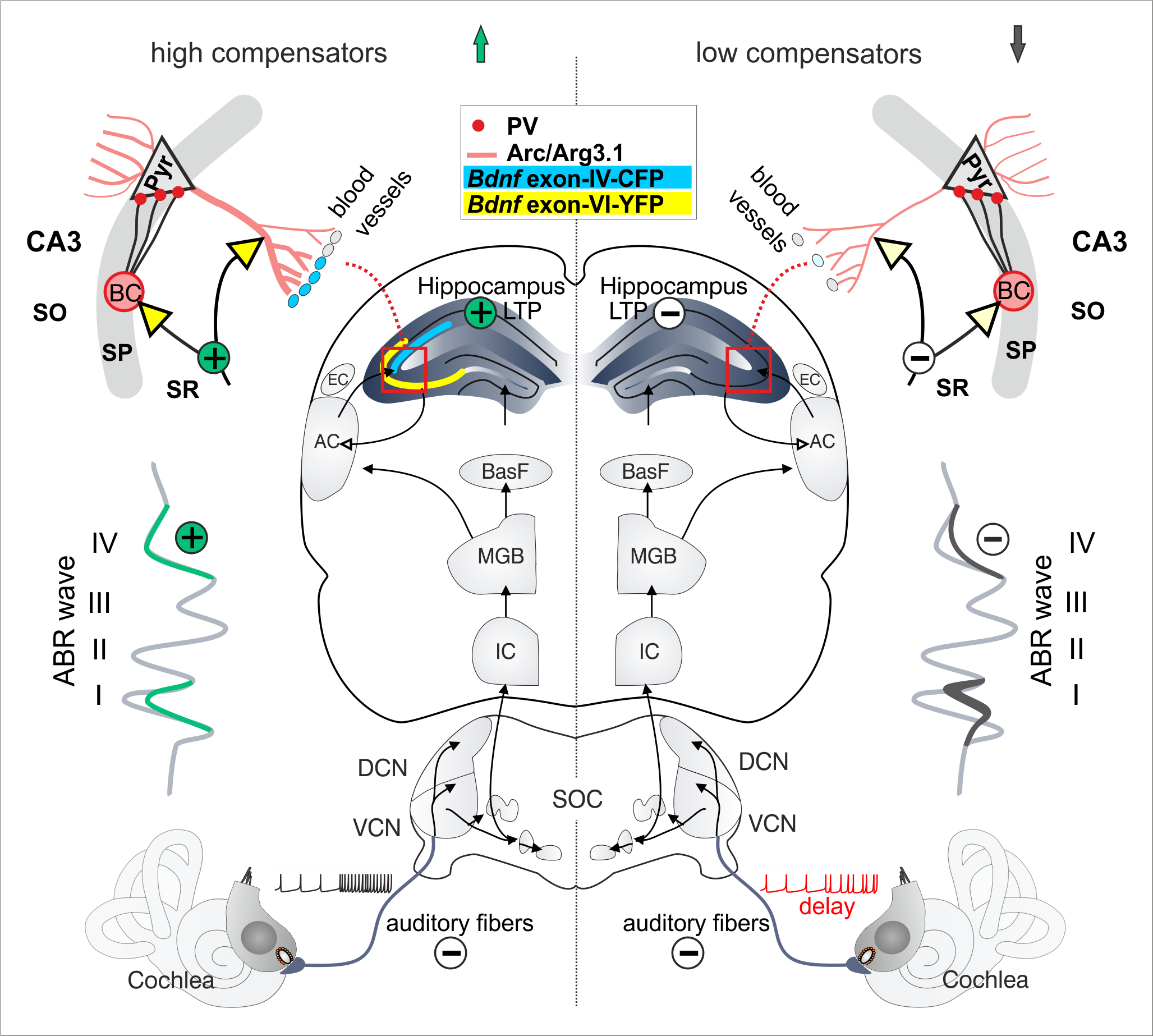
| Figure | Comparison | Statistical Test | Test Value | p-Value | Post-Hoc Test with p-Value | n—Number | |
|---|---|---|---|---|---|---|---|
| Tukey´s multiple comp. Test | |||||||
| Fig. 1a | Click-ABR | 1-way ANOVA | F (2, 157) = 39.70 | p < 0.0001 | Y vs. M-A | p > 0.05 | Y n = 27 animals M-A n = 14 animals O n = 27 animals |
| Y vs. O | p < 0.0001 | ||||||
| MA vs. O | p < 0.0001 | ||||||
| Fig. 1b | Noise-ABR | 1-way ANOVA | F (2, 157) = 27.23 | p < 0.0001 | Y vs. M-A | p > 0.05 | |
| Y vs. O | p < 0.0001 | ||||||
| M-A vs. O | p < 0.0001 | ||||||
| Fig. 1c | f-ABR | 2-way ANOVA | F (2, 741) = 73.33 | p < 0.0001 | Y vs. M-A | p < 0.05 for all freq > 22.6 kHz | |
| Y vs. O | p < 0.05 for all freq shown | ||||||
| M-A vs. O | p < 0.05 for all freq shown except 22.6 kHz | ||||||
| Tukey´s multiple comp. Test | |||||||
| Fig. 2b | ABR wave I ampl. | 2-way ANOVA | F (2, 2214) = 236.1 | p < 0.0001 | Y vs. M-A | p < 0.05 for all SPL > 20 dB re Thr | Y n = 24 animals M-A n = 25 animals O n = 22 animals |
| Y vs. O | p < 0.05 for SPL between 15 and 85 dB re Thr | ||||||
| M-A vs. O | p > 0.05 | ||||||
| Fig. 2c | ABR wave IV ampl. | 2-way ANOVA | F (2, 2025) = 414.7 | p < 0.0001 | Y vs. M-A | p < 0.05 for all SPL > 15 dB re Thr | |
| Y vs. O | p < 0.05 for all SPL > 20 dB re Thr | ||||||
| M-A vs. O | p < 0.05 for SPL between 50 and 75 dB re Thr | ||||||
| Fig. 2e | IHC ribbons apical | 1-way ANOVA | F (2, 85) = 11.34 | p < 0.0001 | Y vs. M-A | p < 0.01 | Y n = 7 animals M-A n = 8 animals O n = 7 animals |
| Y vs.O | p < 0.001 | ||||||
| M-A vs. O | p > 0.05 | ||||||
| IHC ribbons medial | 1-way ANOVA | F (2, 88) = 4.61 | p = 0.0125 | Y vs. M-A | p > 0.05 | ||
| Y vs. O | p < 0.05 | ||||||
| M-A vs. O | p > 0.05 | ||||||
| IHC ribbons midbasal | 1-way ANOVA | F (2, 85) = 11.34 | p < 0.0001 | Y vs. M-A | p < 0.01 | ||
| Y vs. O | p < 0.001 | ||||||
| M-A vs. O | p > 0.05 | ||||||
| Fig. 3b | Amplification Y | Regression | y = 0.9322x + 1.7392 | R2 = 0.6005 | Y n = 34 animals M-A n = 29 animals O n = 29 animals | ||
| Amplification M-A | y = 0.9081x + 1.1758 | R2 = 0.7313 | |||||
| Amplification O | y = 0.8248x + 0.6833 | R2 = 0.5378 | |||||
| Comparison between ages | Steepness of regression lines | F (2, 86) = 0.12 | p = 0.883 | ||||
| Are regression lines different? | F (2, 88) = 20.79 | p < 0.0001 | |||||
| Fig. 3c | Compensation Y | Regression | y = 2.2714x−0.277 | R2 = 0.2768 | |||
| Compensation M-A | y = 2.3313x−0.532 | R2 = 0.3446 | |||||
| Compensation O | y = 2.6943x−0.502 | R2 = 0.2068 | |||||
| Compensation all | y = 2.4733x−0.405 | R2 = 0.2815 | |||||
| Bonferroni’s multiple comp. test | |||||||
| Fig. 4a | ABR wave I strength | 1-way ANOVA | F (2, 35) = 21.98 | p < 0.0001 | HC vs. LC | p > 0.05 | LC n = 5 HC n = 7 Y n = 26 animals mean of both ears |
| Y vs. HC | p < 0.001 | ||||||
| Y vs. LC | p < 0.001 | ||||||
| ABR wave IV strength | 1-way ANOVA | F (2, 35) = 41.15 | p < 0.0001 | HC vs. LC | p < 0.1 | ||
| Y vs. HC | p < 0.001 | ||||||
| Y vs. LC | p < 0.001 | ||||||
| Fig. 4b | ABR wave I latency | 1-way ANOVA | F (2, 36) = 12.55 | p < 0.0001 | HC vs. LC | p < 0.001 | |
| Y vs. HC | p < 0.001 | ||||||
| Y vs. LC | p > 0.05 | ||||||
| ABR wave IV latency | 1-way ANOVA | F (2, 35) = 4.592 | p = 0.0169 | HC vs. LC | p < 0.1 | ||
| Y vs. HC | p < 0.05 | ||||||
| Y vs. LC | p > 0.05 | ||||||
| Fig. 4c | Central conductance | 1-way ANOVA | F (1, 34) = 4.045 | p = 0.0266 | HC vs. LC | p > 0.05 | |
| Y vs. HC | p > 0.05 | ||||||
| Y vs. LC | p < 0.05 | HC n = 7 LC n = 6 | |||||
| Fig. 4d | IHC ribbons apical | 1-way ANOVA | F (2, 34) = 9.1 | p < 0.001 | HC vs. LC | p > 0.05 | Y n = 7 animals M-A n = 8 animals O n = 7 animals |
| Y vs. HC | p < 0.05 | ||||||
| Y vs. LC | p < 0.001 | ||||||
| IHC ribbons medial | 1-way ANOVA | F (2, 35) = 9.72 | p < 0.001 | HC vs. LC | p < 0.05 | ||
| Y vs. HC | p > 0.05 | ||||||
| Y vs. LC | p < 0.001 | ||||||
| IHC ribbons midbasal | 1-way ANOVA | F (2, 35) = 41.93 | p < 0.0001 | HC vs. LC | p < 0.001 | ||
| Y vs. HC | p < 0.01 | ||||||
| Y vs. LC | p < 0.001 | ||||||
| Fig. 4e | ASSR input–output function | 2-way ANOVA | F (1, 106) = 7.52 | p = 0.0072 | HC vs. LC | p > 0.05 | HC n = 7 LC n = 6 |
| Fig. 5b | HC baseline vs. post HFS | Mann–Whitney U | U (21) = 0 | p < 0.0001 | n = animals/slices Y n = 7/21 HC n = 7/21 LC n = 5/15 | ||
| LC baseline vs. post HFS | U (15) = 0 | p < 0.0001 | |||||
| Fig. 5c | LTP HC vs. LC | Mann–Whitney U | U (21, 15) = 74 | p = 0.0066 | |||
| Two-stage linear step-up procedure of Benjamini, Krieger, and Yekutieli | |||||||
| Fig. 5d | LTP high and LC dependent on age and Y control group | 1-way nonparametric ANOVA on ranks (Kruskal–Wallis test) | H (5) = 20.18, p = 0.0005 | p < 0.001 | HC M-A vs. O | p < 0.01 | |
| low comp. M-A vs. O | p > 0.05 | ||||||
| Y vs. M-A HC | p > 0.05 | ||||||
| Y vs. M-A LC | p > 0.05 | ||||||
| Y vs. O HC | p > 0.05 | ||||||
| Y vs. O LC | p < 0.01 | ||||||
| M-A HC vs. LC | p < 0.01 | ||||||
| O HC vs. LC | p > 0.05 | ||||||
| Fig. 6c | Bdnf exon-IV-CFP | Mann–Whitney U | U (4) = 24.31 | p < 0.0001 | |||
| Bdnf exon-IV-YFP | U (4) = 4.994 | p = 0.0075 | |||||
| Parvalbumin | U (4) = 2.127 | p = 0.1005 | |||||
| Fig. S1b | IOR fEPSP slope | 2-way ANOVA | F (2, 300) = 1.446 | p = 0.2371 | |||
| Two-stage linear step-up procedure of Benjamini, Krieger, and Yekutieli | n = animals/slices Y n = 7/21 HC n = 7/20 LC n = 5/12 | ||||||
| Fig. S1c | IOR fiber volley amplitude | 2-way ANOVA | F (2, 300) = 4.127 | p = 0.0171 | HC vs. LC | p > 0.05 | |
| Y vs. HC | p > 0.05 | ||||||
| Y vs. LC | p > 0.05 | ||||||
| Fig. S1d | fEPSP slope vs. fiber volley amplitude | Difference between regression lines (slopes) | F (2, 323) = 0.69 | p = 0.5023 | |||
| Fig. S2b | Paired-pulse ratio EPSP2/EPSP1 (slope) | 2-way ANOVA | F (2, 330) = 0.9445 | p = 0.3899 | n = animals/slices Y n = 7/21 HC n = 7/20 LC n = 5/16 | ||
| Two-stage linear step-up procedure of Benjamini, Krieger, and Yekutieli | |||||||
| Fig. S2c | Paired-pulse ratio EPSP2/EPSP1 (amplitude) | 2-way ANOVA | F (2, 330) = 4.487 | p = 0.0120 | HC vs. LC | p > 0.05 | |
| Y vs. HC | p > 0.05 | ||||||
| Y vs. LC (only at 10 ms interpulse interval) | p < 0.01 |
© 2020 by the authors. Licensee MDPI, Basel, Switzerland. This article is an open access article distributed under the terms and conditions of the Creative Commons Attribution (CC BY) license (http://creativecommons.org/licenses/by/4.0/).
Share and Cite
Marchetta, P.; Savitska, D.; Kübler, A.; Asola, G.; Manthey, M.; Möhrle, D.; Schimmang, T.; Rüttiger, L.; Knipper, M.; Singer, W. Age-Dependent Auditory Processing Deficits after Cochlear Synaptopathy Depend on Auditory Nerve Latency and the Ability of the Brain to Recruit LTP/BDNF. Brain Sci. 2020, 10, 710. https://doi.org/10.3390/brainsci10100710
Marchetta P, Savitska D, Kübler A, Asola G, Manthey M, Möhrle D, Schimmang T, Rüttiger L, Knipper M, Singer W. Age-Dependent Auditory Processing Deficits after Cochlear Synaptopathy Depend on Auditory Nerve Latency and the Ability of the Brain to Recruit LTP/BDNF. Brain Sciences. 2020; 10(10):710. https://doi.org/10.3390/brainsci10100710
Chicago/Turabian StyleMarchetta, Philine, Daria Savitska, Angelika Kübler, Giulia Asola, Marie Manthey, Dorit Möhrle, Thomas Schimmang, Lukas Rüttiger, Marlies Knipper, and Wibke Singer. 2020. "Age-Dependent Auditory Processing Deficits after Cochlear Synaptopathy Depend on Auditory Nerve Latency and the Ability of the Brain to Recruit LTP/BDNF" Brain Sciences 10, no. 10: 710. https://doi.org/10.3390/brainsci10100710
APA StyleMarchetta, P., Savitska, D., Kübler, A., Asola, G., Manthey, M., Möhrle, D., Schimmang, T., Rüttiger, L., Knipper, M., & Singer, W. (2020). Age-Dependent Auditory Processing Deficits after Cochlear Synaptopathy Depend on Auditory Nerve Latency and the Ability of the Brain to Recruit LTP/BDNF. Brain Sciences, 10(10), 710. https://doi.org/10.3390/brainsci10100710




